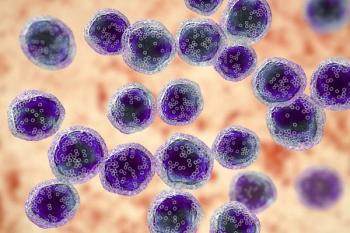
Efficacy of Rituximab Biosimilar in Follicular Lymphoma
A phase III study looks at the efficacy and safety of rituximab biosimilar CT-P10 in patients with follicular lymphoma.
Monotherapy with CT-P10, a monoclonal antibody that targets CD20 and is designed to be a biosimilar of rituximab, resulted in similar efficacy and safety as treatment with rituximab in a phase III study of patients with low-tumor-burden follicular lymphoma.
The proportion of patients achieving an overall response at 7 months, the study’s primary endpoint, was similar between patients treated with CT-P10 (83%) and those treated with rituximab (81%).
Based on these
In a comment published with the study, Brian K. Link, MD, of University of Iowa Hospitals, noted that current consensus “would discount overall response at 7 months as an effective endpoint when trying to identify strategies that improve outcomes in patients with follicular lymphoma.” However, the importance of the trial by Ogura et al is the identification of treatment options at sustainable costs that do not sacrifice safety or efficacy, he wrote.
“From 2011–2016, the US health care system spent more money (US$3.5 billion mean annual expenditure) on rituximab than any other antineoplastic biologic,” Link wrote. “Ogura and colleagues point out that biosimilar drugs are generally associated with a 20%–35% reduction in price vs the originator product, and although their study reports no data on cost reduction, others have estimated that a 20% reduction in the price of five leading off-patent biopharmaceuticals could result in savings in excess of €1.6 billion in the European Union and in the range of US$9–12 billion for the US Federal Government over the next 10 years.”
“With the results from Ogura and colleagues' study, one can reasonably conclude that in patients with low-tumor-burden follicular lymphoma, little is risked by using CT-P10 vs other choices when choosing an anti-CD20 antibody as monotherapy,” Link wrote.
The phase III study included 402 adult patients with stage II-IV low-tumor-burden follicular lymphoma who were randomly assigned to CT-P10 or rituximab. Patients with disease control after induction continued on maintenance CT-P10 or rituximab. If initial maintenance was completed, patients could have a second year of maintenance with CT-P10.
The median follow-up was 6.25 months. Overall response at month 7 was similar between the two treatment arms with a treatment difference estimate of 1.8% (83% vs 81%; 90% CI, 6.43–10.20). Therapeutic equivalence was shown as the 90% CIs were within the prespecified margin of 17%.
Common grade 3/4 adverse events were decreased neutrophil count and neutropenia. Five percent of patients assigned CT-P10 and 2% of patient's assigned rituximab experienced at least one treatment-emergent serious adverse event.
“Rituximab monotherapy is a cost-effective strategy for induction treatment of asymptomatic follicular lymphoma as compared with a watchful waiting strategy, and is recommended treatment for this patient population according to guidance from the National Institute for Health and Care Excellence and National Comprehensive Cancer Network,” Ogura and colleagues wrote. “Results from our multinational, phase III, randomized controlled trial suggest a role for CT-P10 as a potential alternative to rituximab.”
Newsletter
Stay up to date on recent advances in the multidisciplinary approach to cancer.






















































































